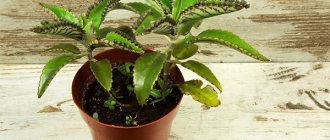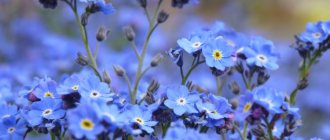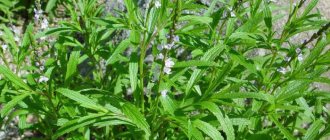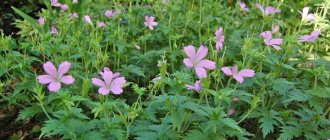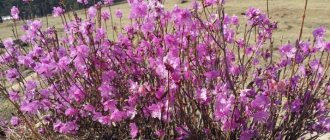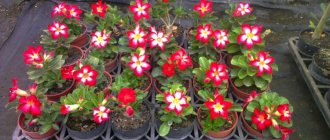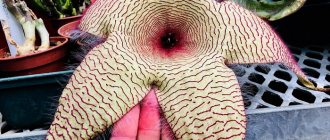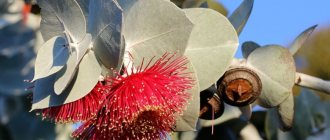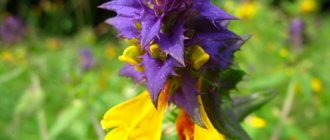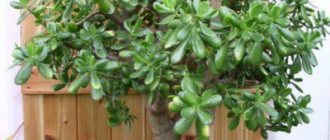Geranium is the most famous indoor plant. It is easy to care for and propagating it will not be difficult. There are many varieties and types of geraniums.
Geranium is an annual and perennial plant with stems about 50 cm high. The leaves of the plant are bright dark green in color. Geranium flowers are very beautiful and large; in some species they are collected in inflorescences. And geranium leaves have a refreshing, minty and lemon aroma. The leaves have a pattern that can be in the form of a white border or stripes of various colors.
And now geranium is the most favorite indoor plant among the rest. In almost every family you can see this beautiful, unpretentious, hardy flower on the windowsill.
Geranium also grows wild. It can be seen in the meadows of the Caucasus and Europe, in the southern mountains. Almost all types of geranium have an average moisture requirement. In order for geraniums to grow normally, they need constant watering and loosening of the soil. The best soils for geraniums are acidic, neutral and slightly acidic soils. The main condition for the growth of each type of geranium (except for marsh geraniums) is the absence of stagnant water. Geraniums are frost resistant.
Geranium blooms very beautifully. Umbrellas of flowers are located on a thin stem, and the leaves are very similar to the palm of a person. If the geranium does not receive enough light, it will reduce its flowering, and the flowers and leaves will become faded.
What does geranium look like?
The botanical name of geranium is pelargonium domestica. It grows as a small shrub with erect stems that can be drooping. The foliage is round or rugged, covered with small fibers. The color is green, and there are also varieties with variegated foliage. The flowers are smooth or velvety, collected in inflorescences. Most often it blooms in red, but there are white, pink and other colors. The plant has a specific rich aroma. There are 250 of its varieties: some of them can be planted in open ground or in hanging pots.
Preparation and storage of geraniums
The most beneficial substances are contained in red meadow geranium. This plant uses leaves, stems, and roots. In other species, only the aerial part is collected.
We recommend: Is it possible to keep chocolate in the refrigerator - they say it spoils because of this
The leaves, flowers and stems of meadow geranium are collected during its flowering. The raw materials are dried under canopies or inside special dryers at a temperature of 45C. Then they are crushed and stored in glass or wooden containers for no more than a year.
The roots are collected in the fall (the best months for this are September and October). They are washed and dried at a temperature of 60C. The roots are stored longer - up to two years - in bags made of natural fibers.
If you want to use your homemade geranium for treatment, you do not need to prepare it specially. Freshly picked leaves with flowers are suitable for preparing decoctions and infusions.
Chemical composition of geranium
The benefits of geranium depend on a set of chemical elements that provide the flower with healing properties.
The plant contains:
- tanning agents;
- useful acids;
- esters;
- flavonoids;
- pectin;
- carotene;
- ascorbic acid;
- glucose;
- fructose;
- alkaloids;
- vitamins;
- minerals.
Thanks to such a wealth of beneficial elements, geranium helps to cure many diseases. The plant essential oil has a calming effect. Helps cope with stress. Young foliage relieves inflammation and normalizes digestion. Useful decoctions of the flower remove salts and stop bleeding.
Geranium for diseases of an important organ
How many people, having geranium at home, do not know that it is the main healer of the thyroid gland.
You can prepare an external remedy: grind dry leaves into powder, add them to oil or cream, and lubricate the thyroid gland from the outside.
The thyroid gland will become healthy again if you use a very effective remedy:
- Fill a liter jar to the top with washed pelargonium leaves;
- Pour in 500 ml of vodka.
Place the jar in a dark place for three weeks. After 3 weeks, mix everything well, leave to infuse for another 1 week.
How to use? Drink the strained liquid 30 minutes before meals, 1 tbsp. spoon. As soon as the product runs out, prepare a new composition. It will take approximately 6 months to treat the nodes. Get your blood tested periodically.
A powerful drug for the treatment of thyroid nodules.
Ingredients:
- geranium, preferably red - 20 g;
- honey - 1 tbsp. spoon;
- water - 500 ml.
Preparation:
Brew a few sprigs of red medicine with flowers in boiling water. Add honey, stir, let stand for 10 minutes, strain. Drink 1 sip throughout the day. Course - 3 weeks. Begin treatment on the waning moon.
What diseases does geranium help with?
The benefits of geranium, as a source of medicinal elements and beneficial properties, are irreplaceable for humans. These include:
- normalization of blood pressure;
- improved blood circulation;
- normalizing the functioning of the heart and muscular system;
- relieving headaches and toothaches;
- improvement of gastrointestinal tract functions;
- properties to cure otitis media, osteochondrosis, radiculitis;
- remove kidney stones.
The beneficial properties of pelargonium also help cope with colds and viral diseases. The juice from the leaves is used to treat a runny nose, and the infusion is used to treat a sore throat. Despite the fact that pelargonium has a lot of healing properties, it also has some contraindications. In order not to harm the body, the use of products based on it is limited for the following problems:
- asthma;
- individual intolerance and allergic reactions;
- diseases of the digestive system of a chronic nature;
- thrombosis: geranium juice tends to thicken the blood;
- pregnant and nursing mothers.
Geranium - medicinal properties
Geranium has amazing properties. This flower has a complex effect on the body, which has a beneficial effect on the general condition of a person.
Among the medicinal properties are:
- antiseptic;
- bactericidal;
- pain reliever;
- wound healing;
- anti-inflammatory;
- antivirus;
- hemostatic;
- decongestant;
- diuretic;
- antidiabetic;
- anticancer effect.
Due to its antibacterial and antiseptic properties, geranium can be used to treat infectious and viral diseases.
Three-leaf watch - medicinal properties and use in medicine
Benefits of geranium
Geranium has many beneficial properties for humans. For example, a plant releases bactericidal substances into the air. And these substances destroy various types of microbes, including staphylococcus.
The herb, flowers, roots and leaves of geranium are used for medicinal purposes. Preparations from this plant contain gallic acid, starch, pectin, tannins and gum, due to which they have a tightening effect on the human body. Geranium is an obstacle to the secretion of fluids in the body. The plant is used for pharyngitis, nosebleeds and other bleeding as a hemostatic agent.
Geranium helps get rid of insomnia, relieve fatigue, and normalize the nervous system. Geranium tea is taken in case of intestinal upset or dysentery.
Traditional medicine recipes based on geranium
Considering the benefits and harms of geranium, medicinal infusions and decoctions for health are actively prepared from it according to folk recipes. Pelargonium is used externally and internally. It has antimicrobial, anti-inflammatory properties, is a powerful antidepressant, having a positive effect on physical condition and mental productivity.
It is worth paying attention to the benefits of geranium tea. The drink removes anxiety, improves mood, stimulates brain function without harm to the body.
Geranium is also great for women. Its properties to normalize hormonal levels relieve pain during menstruation and menopause. The plant is useful not only for preparing raw materials with healing properties, but also simply to keep in an apartment or house. Healers claim that geranium growing indoors also has properties to prevent the appearance of malignant tumors.
For insomnia and epilepsy
Thanks to the beneficial phytoncides contained in geranium, its aroma helps to cope with insomnia. If you have sleep disturbances, the plant should be placed in the bedroom and kept there until sleep returns to normal.
For insomnia, you can prepare a sedative, the beneficial properties of which will also help in case of epilepsy attacks.
To do this you need:
- Pour crushed plant root into cooled boiled water - 1 tbsp. l.
- Boil for 10 minutes.
- Leave for 1 hour.
Take a healthy infusion of 2 tbsp. l. throughout the day, no more than 10 times. Excessive consumption may cause harmful side effects.
For toothache
The benefits of geranium leaves are also used in recipes for toothache: it is recommended to chew a leaf of the plant and then apply it to the sore gum or tooth for 20 minutes. As an option, the crushed leaf can be glued with an adhesive plaster to the outside of the cheek.
From otitis media
Thanks to the useful tanning substances and microelements of the plant, otitis media can be treated with its young leaves. For this purpose, they are washed under running water and then inserted into the ear.
This method relieves inflammation and headaches.
You can make an infusion:
- Pour 30 g of geranium leaves into 250 ml of hot boiled water;
- Leave for half an hour, strain.
Drink 0.5 cups per dose.
We recommend reading: Why acupuncture is useful and what it treats
For constipation
The benefits of the pelargonium flower are also evident in the fact that you can prepare an infusion from it that helps relieve constipation.
For this, 2 tsp. chopped herbs pour 2 cups of cooled boiled water.
Leave for 8 hours. Drink a little throughout the day.
With high blood pressure
The benefits and harms of indoor geranium for reducing blood pressure have been studied. To do this, you need to crumple and apply the sheet to your wrist, where the pulse is felt. Hold for 10 - 15 minutes. Beneficial, potent elements will appear through the skin and help reduce blood pressure. You can do it differently. Just take a clean leaf and chew it.
For various skin diseases
Geranium is used to treat cuts, wounds, burns, boils and other skin diseases. Grind the leaves until a paste forms. Apply the resulting raw material to the damaged area, wrap it with film or parchment paper, insulate it and secure it. Apply the bandage at night. For dermatitis and eczema, treating the skin with an infusion of the flower is useful.
For a runny nose
The beneficial properties of geranium allow you to treat a runny nose. You need to squeeze the juice out of the leaves and drop a couple of drops into your nose. This should be done 3-5 times a day until healing.
For radiculitis and osteochondrosis
The health benefits of pelargonium are also used in cases of treatment of osteochondrosis and radiculitis. The greens should be mashed until mushy. Apply to the affected area, cover with a soft cloth and film, insulate and secure. The procedure should be done at night and washed off in the morning.
To remove kidney stones
If you have kidney stones, you need to prepare a useful geranium infusion.
How to prepare it:
- Pour 2 tsp into a glass of boiling water. dry crushed pelargonium roots.
- Place on low heat and bring to a boil.
- Leave for an hour.
- Filter.
Drink 2 tbsp before meals. l. Take 5 times a day. The decoction is good because it does not push out stones, but dissolves them. Therefore, they leave the body without harm or pain.
Special cases of the use of various types of geranium in folk medicine
For hypertension
Infusion of blood-red geranium roots. For 1 glass of boiling water you need to take 1 tbsp. raw materials. The duration of infusion (preferably in a thermos) is 8 hours. It is recommended to consume before meals, 1/3 cup per meal. If necessary, the infusion can be taken at any time, without reference to diet.
To normalize blood pressure
“Indoor geranium” - pelargonium - will help stabilize blood pressure (it doesn’t matter whether it’s high or low). It is necessary to pick 2 leaves, rinse under running water and dry, gently blotting with a napkin. Then the leaves need to be rolled into tubes, and these turundas should be inserted into each ear canal. Within 2 hours, the pressure should return to normal, as evidenced by the appearance of itching. Try to be patient as much as possible. By the way, the leaves must be washed, since dust collects on the hairs of the leaves, which can also cause itching (an allergic reaction may appear after 10 - 15 minutes).
This remedy also helps reduce pain during otitis media - it is enough to carry out the above procedure for 20 minutes.
For tuberculosis
Pour 2 tsp boiling water over 2 cups. meadow geranium roots. After 6 – 8 hours, strain. Take 1/2 cup, depending on your diet. This remedy also helps to get rid of coughs of various etiologies (colds, asthma, etc.).
Internal bleeding
Prepare a decoction: 1 liter of water will require 4 freshly dug roots of fragrant geranium. After the water boils, place the raw materials in boiling water and cook for 20 minutes. Take 100 ml orally with an interval of 20-30 minutes. This remedy can also be used externally to treat bleeding wounds (in the form of compresses).
Geranium oil: properties and applications
The composition of geranium ether is rich in various useful elements. It contains alcohols and hydrocarbons. The phytoncides contained in it, which kill microbes and viruses, are of great benefit. Ether has a number of healing properties because:
- serves as an antiseptic;
- relieves pain;
- relieves inflammation;
- has an antibactericidal effect;
- heals wounds quickly;
- has antidiabetic properties;
- is a good insecticide.
Geranium essential oil is an excellent diuretic, astringent, vasoconstrictor, deodorizing, tonic, and sedative. Due to the large number of beneficial properties and minimal harm, ether is used in folk medicine, cosmetology, and aromatherapy. It is used for hand care and added to foot baths. The product increases muscle tone and helps with cellulite: for these purposes it is used for therapeutic and preventive purposes.
Beneficial properties of indoor geranium
Geranium (ivy-leaved pelargonium) is a plant with antibacterial and antiviral properties. Its essential oils help to quickly cope with the symptoms of colds and flu, and support the immune system. All parts of the plant have medicinal properties; they contain iron, manganese, ascorbic acid, mucous substances, and organic acids.
What are the benefits of geranium:
- Geranium fragrant - a meadow plant contains large quantities of tannins. The leaves contain a lot of essential oils and vitamin C, the roots are rich in calcium. It is recommended to be used to dissolve salt accumulations in cases of gout, kidney stones, and rheumatism. It helps with insomnia, feverish conditions, and dental diseases.
- Blood red geranium has anti-inflammatory, astringent, and hemostatic properties. Helps with dysentery; fresh leaves should be applied to wounds and scratches. In folk medicine, it is used to fight malignant neoplasms, is used in the treatment of fractures, for pathologies of the respiratory and digestive organs, and helps with epilepsy.
- Lemon geranium is a natural antiseptic. Infusions and tinctures for external use help with dermatological diseases - eczema, scabies, ulcers, ulcers. The decoction will help with inflammation of the tonsils, rhinitis, and otitis media. You can use fresh leaves in cooking.
Pelargonium is a safe remedy for diarrhea in a child; it is used to treat ear infections, runny nose and colds even in very young children.
The main contraindications are increased blood viscosity, thrombosis, thrombophlebitis, age-related constipation, gastritis with high acidity. Geranium has a strong odor and can cause allergic reactions, so it is not recommended for pregnant women.
How to make butter at home
Not all varieties are suitable for preparing geranium ether. Pink pelargonium works well. The ether from it has a greenish tint and smells like a rose.
It can be prepared from flowers and leaves.
- Pour 2 tbsp into a glass of clarified butter. l. crushed raw materials.
- Place in a dark place and leave for 5 days.
- After 45 days, keep on a windowsill exposed to the sun.
- Filter, pour into a dark jar or bottle and store on a shelf in the refrigerator.
Oil can be prepared in another way.
In this case, a small amount of ether (1 g) will require a lot of raw materials (500 sheets).
Cooking process:
- Pour some water into the container. For convenience, it is better to use a flask.
- Chop and add leaves.
- Close with a lid or stopper, inserting a glass tube through it into the container so that an angle is formed.
- Place the other end of the tube into a test tube, which is placed in a glass of cold water.
- Using an alcohol lamp, heat the flask with geranium.
- After a while, the foliage will begin to release ether: it will go through the tube along with the steam into the test tube.
- Due to condensation, the steam will begin to turn into a liquid, on the surface of which a film will appear. This will be geranium oil.
- Use a pipette or syringe to collect the ether.
Cooking using the second method is much faster. But the amount of the resulting product may be much less.
Geranium - benefits for the home
In folk practice, there are many recipes based on various parts. But even just a flower growing in a room brings a lot of benefits to the room and its inhabitants.
Back in the middle of the last century, bright plants were kept on the windowsill in almost every home. Our grandmothers considered the flower a talisman for their home.
Geranium has the following properties:
- cleans the air in the room, destroying harmful bacteria;
- enhances the positive energy at home, extinguishes irritation and anger of family members, helps restore relationships between quarreling spouses, has a beneficial effect on the nervous system, helps to relax and promotes sound sleep;
- indoor geranium has an antiviral effect, which is especially important during the cold and flu season;
- the smell of geranium protects the house from unwanted insects. In the summer, in the house where these flowers are planted, you will not find either mosquitoes or annoying flies. In addition, you do not need to use additional anti-moth products. Many gardeners even plant outdoor varieties on the site to preserve the harvest from the invasion of garden pests.
The use of geranium in home cosmetology
The beneficial properties of geranium are actively and without harm used in the cosmetology field. In the manufacture of some cosmetics, flower extract is used as an additive. At home, face and hair masks are prepared from geranium, which:
- strengthen hair;
- rejuvenate the skin and nourish it with beneficial elements;
- improve complexion;
- reduce sebum secretion;
- eliminate acne, pimples, peeling.
To prepare cosmetics, you can use both geranium raw materials and ether.
Mask of geranium leaves for acne on the face
To prepare the mask, you will need geranium leaves and sour cream.
- Grind 2-3 leaves to a paste.
- Add 1 tbsp. l. sour cream and mix well.
- Apply the finished mask to your face.
- After 10 - 15 minutes, rinse with warm water.
Apply the mask no more than once a day.
Geranium for hair loss and dandruff
You can strengthen your hair without harm using geranium infusion, which requires crushing the leaves.
We recommend reading: The benefits and harms of Tremella fuciformes (ice mushroom)
- 3 tbsp. l. pour two cups of boiling water over the raw material and cool.
- Wet the hair along the entire length with the infusion.
- Do not rinse off.
You can prepare a mask against hair loss with geranium ether.
You will need 50 ml of base oil (olive, peach, etc.).
- Heat the base in a water bath.
- Add 5 drops of geranium and 3 drops of cedar ether and mix.
- Apply to hair for half an hour.
- Rinse thoroughly.
An anti-dandruff mask can be prepared as follows:
- Grind a large aloe leaf.
- Add 20 g of honey, 10 ml of lemon juice and 2 drops each of geranium, eucalyptus and fir oils.
- Mix all ingredients thoroughly.
Apply with massaging movements to the scalp and distribute over the entire length of the hair. Leave for 40 - 45 minutes, rinse.
A mask that strengthens hair and eliminates dandruff is made from geranium and nettle.
You will need:
- 3 tbsp. l. dry nettle leaves;
- 3 tbsp. l. dry geranium;
- 5 drops of any ether - to suppress the smell of grass.
- Pour a glass of boiling water over the dry raw materials.
- Cover and cool.
- Filter through gauze cloth.
Apply the mask to your hair, massaging into the roots. Leave for half an hour, then rinse with clean cool water.
Herbal medicines
To use the healing properties of geranium, you can prepare homemade medicines based on it. Traditional medicine recipes include infusions, decoctions and alcohol tinctures.
Infusion
Pour 1 tbsp. chopped greens 250 ml boiling water. Leave to infuse for 15 minutes. Strain. Take the infusion 1 tbsp. 3 times a day.
Decoction
Mix equal parts of greens and roots. 1 tsp raw materials, pour 250 ml of water, cook for 5 minutes. Cool and strain. The decoction is used for gargling for throat diseases and stomatitis.
In folk medicine, infusion and decoction are recommended for cleansing blood vessels, relieving coughs and inhibiting inflammatory processes in the body. Used as a compress liquid for rheumatic diseases, skin inflammations and herpetic lesions.
Alcohol tincture
Grind the greens to a paste consistency. 3 tbsp. pour 100 ml of vodka or 40% alcohol. Leave for 3 days. Strain through cheesecloth. Application of tincture: 1/2 tsp. with 1 tbsp. water 2 times a day.
Use of essential oil
Geranium essential oil has a distinct floral aroma with a spicy undertone. In recent years, it has been used mainly due to its effects on the human psyche. This is a natural antidepressant with a calming, stimulating and harmonizing effect.
How to use it? Mainly in aromatherapy. Drop a few drops of essential oil into the aroma lamp and enjoy its positive effects on the psyche. Such treatments are recommended in particular for women due to their ability to relieve symptoms of PMS and menopause. Essential oil stabilizes female hormones and reduces bleeding during menstruation.
Aromatherapy with geranium oil will help with migraines. Place 4 drops directly into the bath (37˚C). Thanks to its ability to stimulate the nervous system, the natural remedy relaxes the body, dilates blood vessels and, therefore, eliminates pain.
Baths are also suitable for men, who, due to the modern stressful lifestyle, are becoming increasingly susceptible to heart diseases that develop against the background of stressful conditions. Let’s summarize the uses of geranium essential oil:
- for aromatherapy purposes;
- in mixtures with shea butter or other moisturizing oil, used to treat skin diseases;
- provides a pleasant atmosphere in the home;
- when added to a bath, improves mood and relaxes;
- will help with psoriasis and other dry inflammatory skin diseases;
- suitable for removing scars and scars;
- helps stabilize hormonal fluctuations during menstruation and menopause;
- has an anti-inflammatory effect;
- useful for varicose veins;
- used as a massage product for cellulite;
- used to treat influenza, colds, laryngitis, spasmodic cough, rhinitis, sinusitis;
- has an analgesic effect, reduces otitis media, eliminates inflammation in the oral cavity (stomatitis);
- useful for gastritis, inflammatory processes in the intestines, stomach ulcers, dyspepsia;
- has antidiabetic properties;
- regulates cardiac activity, prevents thrombosis;
- normalizes blood pressure;
- stops nasal and uterine bleeding;
- has an anti-shock effect;
- stimulates cell regeneration;
- has a mild diuretic effect, helps with edema, cystitis, kidney and bladder stones;
- stimulates the immune system.
What are the benefits of geranium in the home?
It is recommended to grow the flower at home, even if it is not intended to make infusions and decoctions from it. It will not only decorate the windowsill, but will also purify the air from bacteria and repel insects. In addition, the aroma of the plant calms the nerves, relieves headaches and has a positive effect on the entire body.
There is an opinion that the benefit of pelargonium for the home lies in its ability to ward off envy, damage and slander from housing and family. She is also credited with the ability to prevent conflicts and quarrels.
But growing geranium, which brings so many benefits, can also turn into harm when someone in the household is allergic to it: you need to be especially careful when growing the plant if there are children in the house. Do not allow pets to eat geranium foliage; this can also cause adverse reactions.
Contraindications
It should be remembered that any medicinal plants have contraindications. The flower has a strong healing effect, but remedies from the plant cannot be treated uncontrollably.
Treatment with geranium at home is contraindicated for:
- low blood pressure;
- intestinal atony (can lead to indigestion);
- increased blood clotting (the flower thickens the blood), thrombophlebitis and varicose veins;
- high body temperature;
- chronic diseases of the gastrointestinal tract.
Children, pregnant women, and elderly people are allowed to use pelargonium only for external treatment.
Allergic reactions to the plant are manifested by pain in the eyes, sneezing, runny nose, and painful sensations in the throat. If similar symptoms occur, avoid treatment with geranium.
Signs and superstitions about geranium
Geraniums have been grown in homes since ancient times. Some people use it for decoration, some as a remedy, and others endow pelargonium with magical properties.
Folk beliefs associated with geranium:
- If pink pelargonium flowers bloom in a house, someone living there will get engaged or fall in love in the near future.
- In Feng Shui, it is believed that flowering geraniums remove all bad energy from the house.
- Pelargonium attracts love to the family.
- Geranium attracts prosperity and money, so it would be a good idea to carry a dried leaf or flower in your wallet.
- The plant with white flowers is credited with the ability to attract clients, so placing it in your office would be a good idea.
- The flower protects against evil forces and negative energy: it protects against the evil eye, helps against conspiracies and love spells.
Whether or not to believe in the magical properties of geranium is everyone’s business. But the fact that the aroma of geranium invigorates and helps cope with fatigue cannot be denied.
In any case, geranium will bring more benefits in an apartment, and only in rare cases can a flower cause harm in the form of a response from the body.
Geranium - contraindications
The use of decoctions, tinctures, infusions and other medicinal preparations from pelargonium is not recommended for people over 60 years of age and for pregnant women. To treat children, geranium leaves can only be used externally (for example, to treat bruises and wounds).
The use of geranium is contraindicated for the following diseases and conditions:
- Ulcer of the stomach and duodenum. For these diseases, you cannot use concentrated decoctions and infusions, which will act as irritants to the mucous membrane.
- Tendency to thrombosis. The reason is that the hemostatic property of pelargonium increases blood viscosity.
- People prone to allergic reactions. Essential oils in geranium can cause hives, cough, allergic rhinitis, tearing and even swelling of the throat.
- Hypotension. The reason is that pelargonium can lower blood pressure. It can be used to lower blood pressure, but only if special drugs are not already used.
Now you know about the beneficial properties of indoor geranium, the benefits and harms of geranium for the home, how and where it can be used. Before using pelargonium for treatment, it is recommended to consult a doctor. When using a decoction or infusion for the first time, take a small dose to see how your body reacts.
Mistakes when caring for indoor geraniums
Illiterate care is the main reason for the appearance of yellow leaves in geraniums. This is an unpretentious plant to grow, but the basic rules for its development must be followed. Knowing the typical mistakes, it is easier to understand what your favorite indoor flower needs.
Wrong capacity
The choice of a pot for pelargonium must be approached very carefully. Some novice gardeners wrongly believe that the roots need a lot of space. But this is not suitable for all plants.
Indoor geranium in a tight container will quickly fill the entire space with roots and the growth of the plant will slow down. As a result, the leaves will begin to turn yellow and dry out. Using a very large flowerpot is also not an option. In a spacious pot, pelargonium will begin to intensively grow its root system, devoting all its strength to this process. For this reason, flowering will be delayed.
Over a large area there is a risk of moisture stagnation, which will lead to the development of rot.
Lack or excess lighting
Pelargonium is a light-loving flower. It is better to place it on a windowsill where there is enough light. In the shade, a yellow edging will form on the leaves and they will begin to dry out. But direct rays of the sun are also detrimental to pelargonium. They cause brown burns.
Watering too much
Indoor geranium is a drought-resistant species, this should be taken into account when caring. It is enough to water once a week. During hot summers, the frequency of moisturizing can be increased. The plant does not tolerate excess moisture. A characteristic sign is the appearance of yellowness on the foliage.
Lack of regular watering
Indoor geranium is capricious regarding watering. It does not tolerate a lack of moisture and does not respond well to waterlogging. You need to find a compromise: water the soil when it dries 2.5 cm. If this is difficult to monitor, then mulching the soil would be a good option. Pine bark, peat, crushed stone, tea, moss, and marble chips are suitable for this. The time between watering will increase, there will be no risk of rot spreading, and yellowing of the leaves will be prevented.
Incorrectly selected soil
In order for pelargonium roots to grow well, you need a special loose, fertile soil mixture. You can buy it in the store. Soil collected in the yard or forest may be unsuitable for indoor geraniums and will cause poor development and lack of flowering.
Also read the article about varieties of pelargonium and proper care for it.
Increased air humidity
Not only the root system, but also the leaves are sensitive to excess water.
Do not spray the plant with a spray bottle. This will negatively affect the color of the greens; they may turn yellow.
Heat
Indoor geranium grows best at a temperature of +20 °C. High degrees cause yellowness on the leaves. This happens especially often in winter, when heating radiators strongly heat the air near the windowsill on which the plant stands. When it gets colder, the development of pelargonium slows down and flowering is delayed. She is preparing to die.
No fertilizer
Active growth and rapid flowering require good feeding. This requires iron, phosphorus, and potassium. Nutrients must be added regularly once a month. You can buy a universal mixture for indoor flowering plants with a low nitrogen content.
We recommend reading the article about why your pelargonium may not bloom.
Herbicide ingress
When the leaves of indoor geraniums turn yellow and dry, there is a possibility that chemicals, such as weed control drugs, will come into contact with the plant. Pelargonium is sensitive to household household hygiene and cosmetic products - air fresheners, hair sprays.
Drafts
Indoor geraniums are often placed on window sills. Not surprisingly, this beautiful plant is always pleasing to the eye. But regular ventilation harms the appearance of pelargonium. The leaves begin to turn yellow and dry out, and gradually they all fall off. You can correct the situation by choosing a place without wind.
Poor or no drainage
To remove excess moisture from the root system, the pot must have a drainage layer. In its absence, the process of decay begins, which gradually destroys the entire plant. Its beginning can be determined by the leaves. They begin to turn yellow for no apparent reason.
Rules for home care of pelargonium
Caring for fragrant pelargonium at home is simple. It is enough to follow a few rules. In the garden the plant will feel good until the onset of cold weather. Since South Africa is its homeland, when the temperature drops to +10 degrees the plant must be replanted. By this time, the plant has formed a lush crown, forming a lush bush. In order not to harm the plant, in the spring it can be buried in the flowerbed along with the pot.
Top dressing
Pelargonium is responsive to soil fertilizers, but you should not apply concentrated solutions or organic matter under the bush. At the beginning of spring, when the plant is just waking up, nitrogen-containing fertilizers are suitable. They will help “wake up” the buds and form a lush crown. Before the formation of buds begins (April), it is necessary to add potassium and phosphorus. This will help to form beautiful, lush blooms.
The soil
For geraniums, soil from the store or prepared independently is suitable. The latter must meet the basic requirements: be loose, have neutral acidity, and contain nitrogen. To prepare the soil yourself, you will need garden soil, leaf humus, and sand in a ratio of 9:1/2:1. You can add ash and peat in small quantities. Pelargonium does not require a large pot and it is better to replant it once a year in the spring. The new pot should be 1-2 centimeters larger than the previous one, equipped with a drainage hole and a drainage layer. As the latter, you can use expanded clay, broken brick or pottery.
Watering
The flower does not tolerate overflow. With excessive watering, it begins to hurt, mold appears, and if this is combined with cold nights, the plant can become infected with powdery mildew. It is worth watering only if the lump of earth is completely dry. Having about 2 centimeters of drainage will help prevent overflow.
What is it needed for in the house, is it good or bad?
Geranium is perfect for home use. It purifies the air, creates a favorable microclimate, and charges household members and guests with positive energy. From an aesthetic point of view, geranium is beautiful when flowering; the variety of species and varieties makes it possible to choose a plant to suit every taste.
It is very useful to keep geranium in the house when there are children in the family, then the medicinal plant for many ailments will be at hand and it will be possible to provide first aid in case of illness.
Geranium is easy to care for, but it is necessary to monitor watering and lighting. In autumn, it is advisable to cut off all shoots , leaving only the stem to stimulate and develop the plant in the future. Geranium not only helps its owner, but also the indoor plants around it, repelling insects and parasites with its aroma, and medicines from geranium are sometimes used to treat and prevent diseases in pets.
Varieties
The Geranaceae family includes 5 genera and 800 plant species. The most common and numerous species is geranium, the most popular among indoor species is pelargonium.
Breeders did not ignore the fragrant features of pelargonium and their main work was aimed at enhancing the smell. This is how varieties appeared with the smell of pine, mint, lemon, nutmeg, apple, peach, rose, lavender, coconut, pineapple, ginger, even mint chocolate.
Mabel Gray
Has a lemon aroma. Currently, the variety has been renamed lemon (P. citronellum). Plants with rough leaves, pronounced veins, and heavily dissected. The inside of the leaf is covered with down. The inflorescence is an umbrella with small lilac-pink flowers. This large plant can grow up to 1-2 meters. Can be used as the basis of a standard culture. In some classifications, this variety is classified as a hybrid of natural origin.
Felt or indoor pelargonium (Pelargonium tomentosum)
Pelargonium with a strong minty scent. This evergreen, low-growing bush spreads and branches heavily. The leaves are covered with small gray fibers, which creates the effect of a felt covering. The flowers are inconspicuous, white, with purple splashes. In the wild, it prefers semi-shaded, well-moistened places with sandy soils in river floodplains and on the edges of forests.
Pelargonium vitifolium
It got its name from its grape-like leaves. It is an erect bush up to 90 centimeters high with white-pink and lilac-pink flowers. The large upper petals have bright dark stripes. In its natural habitat it is found in the south of the Cape of Good Hope along the floodplains of rivers and streams. Very pleasant aroma, a combination of lemon and rose.
Apple cider
A low plant that blooms with small white flowers. The leaf blade is round in shape, the edges are wavy. Has a pleasant apple aroma. Needs regular watering.
Lady Plymouth
A small plant that will look good in containers and flowerpots. The leaf plate is carved with a white stripe along the edge. The foliage exudes the scent of roses. It is necessary to water regularly, but little by little.
Gray lady
With beautiful silvery leaves, lacy edge and deep dissection. The flowering is inconspicuous, small white flowers are collected in an umbrella inflorescence.
Pelargonium crispum
An erect shrub, rarely climbing, the base of the stem becomes woody with age. Can grow up to 70 centimeters. The leaves are arranged alternately, the petioles are long. The leaf blade curls down. The plant has a lemon aroma. The flowers are white, pink or lilac, with bright stripes on the upper petals. Often used in breeding. Used in cooking.
Pelargonium fragrant paniculata
Small plant. The leaves have a pleasant aroma of nutmeg, mint and rose. The flowering period is long: from early summer to October. To preserve it in winter, it is necessary to reduce watering as much as possible and ensure good lighting. The plant is not demanding of air humidity and can tolerate even very dry conditions.
What do extracts help with?
Geranium extracts are something amazing, and below we will tell you why they are useful.
Oil
Geranium oil is obtained from the leaves of the plant by steam-water distillation. Ready-made essential oils can be purchased freely at pharmacies. It has a pronounced aroma and is practically colorless; the liquid is transparent, without precipitation.
Geranium oil is used for:
- ENT diseases;
- neuroses;
- psychoemotional disorders, depression;
- premenstrual syndrome;
- inflammation of the mammary glands;
- skin inflammations;
- cellulite;
- migraines and other diseases.
Essential oil, due to its high content of useful components, has a beneficial effect on the functioning of the heart and blood vessels, equalizes blood pressure, is used to eliminate problems with periodontal disease, as first aid for burns, and is widely used in cosmetology as an addition to masks and tonics.
We invite you to watch a useful video about the healing properties of geranium oil:
Tincture of leaves and roots
Geranium tincture is as popular in alternative medicine as oil.
The medicinal properties of green infusion are used in the treatment of otitis media and other ENT diseases.- An infusion of geranium leaves fights diarrhea and constipation, normalizing intestinal function; mouth rinses for stomatitis have a beneficial effect.
- An infusion of the plant's roots is applicable for diseases of an epileptic nature and convulsive syndromes.
- In cosmetology, geranium infusion is used to rinse hair and wipe the skin of the face and neck.
Geranium infusion can be water or alcohol, and the shelf life of the medicinal product depends on this.
Reproduction methods
There are several ways to propagate pelargonium. Most often, geranium is propagated at home by dividing the bush and cuttings, but it can also be done by seeds. The process is more labor intensive, but the result is a large number of healthy young plants.
Propagation by dividing the bush is best done in spring. A plant whose root system has completely filled the pot and is visible through the hole in the bottom of the pot is suitable. An adult bush is watered abundantly and taken out of the pot. The root system is carefully disassembled and, if necessary, cut off with a sterile knife. Each part should have leaves and roots. The cut areas must be treated with activated carbon and cinnamon powder. After separation, the flowers are planted in small pots. 10-14 centimeters in diameter is enough. If the pot is too large, flowering will occur later or will be postponed until the next year until the plant fills the entire volume of the pot with roots. It is necessary to put drainage at the bottom of the pot. You can prepare the soil yourself or purchase it at the store. The soil from the store must be diluted with garden soil and disinfected. To do this, it is calcined in the oven or spilled with a solution of potassium permanganate.
Propagation by cuttings can be carried out throughout the year, but the best results will come from cuttings taken in the spring. During spring pruning, a large number of cuttings remain, which easily take root. The cut branch should have no more than 2-3 leaves. Very large leaves can be cut in half. The cutting is cut at an angle using a sharp knife or blade. It is better to disinfect it first. The cutting is left at room temperature for several hours until the cut is airy. The finished cuttings are placed in a glass of water. It is better to wrap it in dark paper. In the dark, roots will form quickly. You need to add an activated carbon tablet to the water, and cut a cardboard with a hole along the diameter of the neck, into which to place the cutting. It should not sink much in the water, no more than 1 centimeter, otherwise it may begin to rot. Pelargonium takes root easily if it is simply planted in the ground. A regular plastic cup will do for this. Holes are made in it to drain water, fine drainage and soil are poured. The soil should not be very wet, otherwise the plant will not take root and will begin to rot. At first, do not water the cuttings; you can only lightly spray the ground. If it starts to wilt, cover it with a jar.
Propagation by seeds is a long and painstaking process. Before planting, the seeds must be treated. To do this, they are lightly rubbed on fine sandpaper and soaked in the stimulator for 3 hours. Then soak in clean water for another 3 hours. The soil from the store is oversaturated with nutrients, so it is better to make it yourself. Its composition should include peat, river sand and turf soil in a ratio of 1:1:2. The container for the first planting of seeds should be shallow. The seeds are evenly distributed over the surface at a distance of 5 centimeters from each other. Spray with a fine sprayer; if the ground is dry, cover the container with glass. Shoots will appear within a month. After 3-4 leaves appear, you can transplant them into separate cups or directly into small pots.

